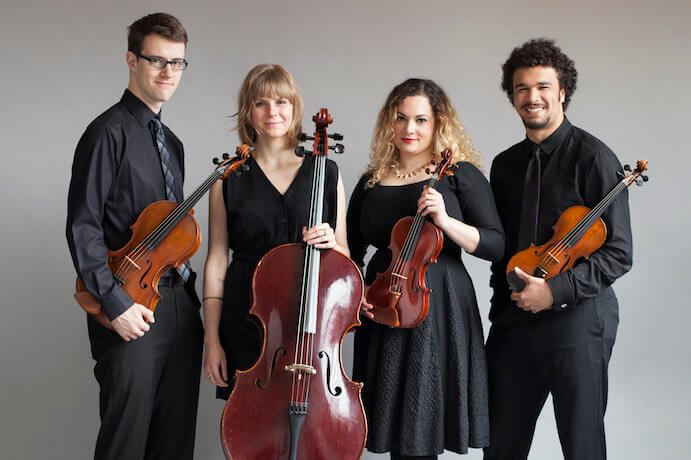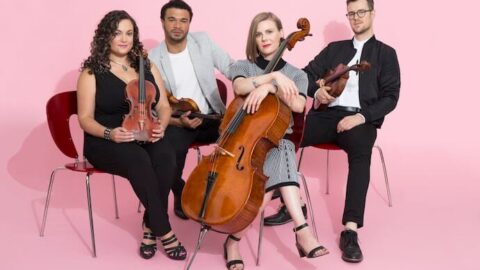PUBLIQuartet, Artists-in-Residence at National Sawdust, is a string quartet seeking to challenge the steadfastness of the Western canon. They adeptly perform in styles that span centuries and genres while also specializing in “open-form improvisation.” PUBLIQuartet demonstrably supports the creation and performance of new music, as seen in their initiatives PUBLIQ Access and MIND THE GAP, and they work in the NYC community with young musicians on string technique and improvisation. PUBLIQuartet will release their new album, Freedom and Faith, in March, marked by a concert at National Sawdust on February 10th. We asked them five questions about their current initiatives and their multi-faceted approach to music making.
Will you please speak about the genesis of PUBLIQuartet and specifically, how you have worked together to create your trademark improvisational style?
Late in 2009, violinist Curtis Stewart, violist Nick Revel, and cellist Amanda Gookin were on break at a bad gig commiserating about the conductor. Amanda was contracting an educational outreach project with Harlem School of the Arts and invited us to read chamber music to get to know each other. Unfortunately, the funding never materialized and the project fell through, but we continued to play together. At that time, hidden gem violinist Jessie Montgomery jumped into our world and we booked our first show at a senior center in Bridgeport, CT to perform a slightly odd debut selection: Beethoven, Shostakovich, and Stravinsky. We were nervous! Our bows shook, our performance outfits were mismatched, and probably our number one goal was to avoid a train wreck.
After that show, we performed in bars, coffee shops, and small house-parties. During a performance at Think Coffee down by NYU, we were concerned that the atonal Webern Fünf Sätze would scare off the studious college kids. To our surprise, many approached us afterwards and sincerely thanked us for a unique musical experience. We learned that most of this music was unheard of outside the classical music community but was often well-received. Playing “strange” music in normal places quickly became part of our early identity, and so we called ourselves PUBLIQuartet. And it stuck.
During breaks in quartet rehearsal, we found ourselves transcribing, imitating our favorite pop songs, and adapting those newfound sounds to our quartet formation. We loved creating spaces where literally ANY sound was acceptable: not a mindset we experienced regularly in conservatory. It evolved into structured improvised musical transitions between concert pieces, and we repurposed the phrase “Mind the Gap” for our own brand of performing. For example, we felt completely comfortable seamlessly improvising transitions between living and dead composers of different nationalities. The audience happily picked up on our energy in those moments of the musical unknown. Our improvisations grew into full-on group compositions, re-imagining, re-inventing, and re-composing works of the greatest composers we knew.
Our current MIND THE GAP repertoire includes re-workings of Bach, Haydn, Debussy, Stravinsky, Dvorak, Charlie Parker, Ella Fitzgerald, Nina Simone, Hildegard von Bingen, and many more

The program for your Freedom and Faith concert looks fantastic–Meredith Monk and Shelley Washington are two of my favorites. Do the programming choices for the album and the concert on February 10th reflect a system that PUBLIQuartet has adopted to ensure equitable programming of non-male and underrepresented composers?
Our system is simple: play the music of composers we love, respect and connect with. It just so happens that many of those composers are female and of “diverse” backgrounds. These are our friends, our casual musical heroes. We are constantly on the lookout for new composers, holding emerging composer competitions, compiling lists of potential programs through a two-step panel process for choosing next years’ works. We are constantly figuring out possibilities of re-working the classical canon, meeting other inspiring musicians on our path, and forging collaborations that excite us.
We think most of that excitement, rather unconsciously, comes from the surprise and challenge of stylistic cross-sections that we personally haven’t seen before in this music; an existence or connection that we were thinking might have been there all along but we never dared to articulate. That twinge and release in the gut is what guides us, that moment when we all exclaim at the feasibility of an idea, when we finally see something in this music that feels like us. It is a novel and intoxicating sensation to see oneself in the music, to identify and reflect, and thereby inversely find music inside of oneself, too. Fortunately for us, there are a lot of possibilities for untapped voices, “diverse” styles and “out of the box” influences to get mixed up within what was maintained as a “pure” art form for so long…classical music. Our system is to open the floodgates.
Freedom and Faith: PQ’s Second Album! from PUBLIQuartet on Vimeo.
Will you expand a little on the intimate concepts of freedom and faith as they apply to this project?
Each of these composers on the album (Hildegard von Bingen, Nina Simone, Jessica Meyer, Ella Fitzgerald, Francesca Caccini, Shelley Washington, Chiara Margarita Cozzolani) have claimed their seat at the table of history with distinction, virtuosity, and a necessary subversive power. They express a unique and personal relationship to Faith; their music touches on the resilience many underrepresented composers must maintain, tapping into Faith in the face of oppression, and sometimes using Faith rhetorically to be accepted by the status quo.
Hildegard is said to have claimed that her talent came directly from God, not her own musicality, thereby allowing for her acceptance in the male-dominated world of church music. Nina Simone said, “Music is the closest thing to God that I know,” and continued to make “Black Classical Music” once she was forced to leave Juilliard due to the wrongs she saw and felt there in the 1950s.
In a way, the album is a theme and variations on oppression and resilience. Each composer used their closeness to music and spirituality to maintain creativity, and to be HEARD; and because of it, these composers’ power, sound, and expression continue to resonate in many shapes and forms. Despite history, their spirits continue to inspire and ring on.
What are some of the best and most challenging things about being a “genre-defying” non-traditional string quartet?
Starting out, we were an unknown quartet, and it was easy to take musical risks, treating public performances as development workshops. Flash forward several years, Jannina Norpoth joined our ranks as Jessie moved on to other endeavors, and we won a new spot on the Concert Artists Guild roster called “New Music New Places,” created specifically for us due in part to our risky re-compositions and improvisations on classical favorites.
Two things happened once we joined CAG. First, our risky behavior took a nap. The pressure of having to perform in front of our managers at an extremely high level got to us and our semi-structured improvisations did not always go according to plan. Second, we learned that most classical presenters do not like to book risky unknown groups. “Mind the what?” “PUBE-lee-kwar-tet?” “Can’t you throw in some Beethoven?” And we did…as our identity continued to nap.
But not for long! Every time we programmed a piece of ours or added some improvisation, we noticed a drastic change in our stage presence, our raw sound energy, and our audience’s reaction. We made a pact to embrace our inner risk-taking edge while also collaborating with presenters. Push back from presenters was and will always be there, but we were and are free to be us. In terms of repertoire, there is no pleasure greater than apologizing to no one about the sounds that are real and powerful for us.

Considering your repertoire and initiatives like MIND THE GAP, who exactly is your music for?
I think our music is primarily for us. We get joy from playing and creating it, and love to share that spirit with whomever is available to listen, whether it be composers or performers who want to open themselves to improvisation in classical music; people new to classical music who don’t have specific expectations about what a string instrument should and shouldn’t do; or classical music lovers who want to reignite how they hear the music.
Secondarily, it is for the waves of musicians and creatives who have come before, to celebrate what is not actually new in music: collaboration and cross-pollination. There are so many musicians who worked tirelessly to be seen in the classical community, just to be pushed away because their music didn’t “fit” (either aesthetically, stylistically, or culturally). Our music is for those who are available to see connection: for those who want to be excited by sound, and to experience potentially surprising sonic stories.
























